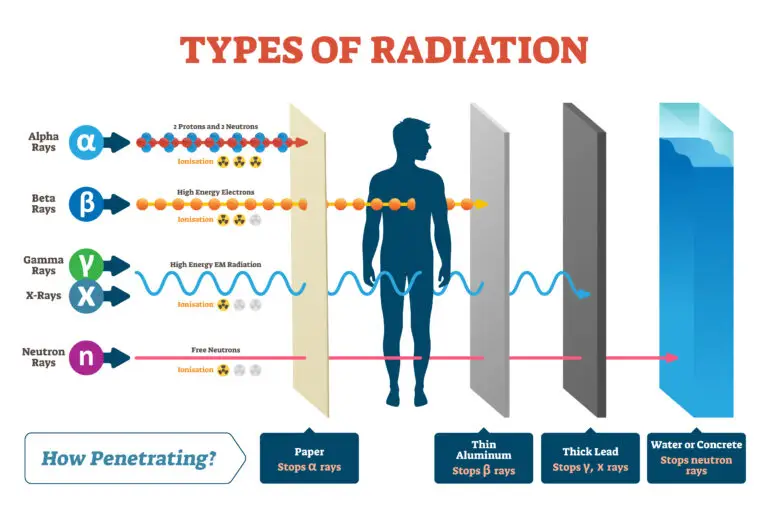Radiation

Table of Contents
What is Radiation?
Radiation is the process by which energy travels through space or a medium in the form of waves or particles. This energy can be in various forms, including electromagnetic radiation, such as light, radio waves, and X-rays, and particle radiation, like alpha and beta particles or neutrons.
Radiation plays a critical role in various phenomena and applications, from the generation of heat and light from the sun, which is essential for life on Earth, to medical applications like X-rays and cancer treatment and technological uses in nuclear power generation and radio communication.
Types of Radiation
Electromagnetic Radiation
Electromagnetic radiation encompasses a broad spectrum of waves with varying wavelengths and frequencies. This spectrum includes:
- Radio waves: With the longest wavelengths and lowest frequencies, radio waves are used in communication technologies, such as television, radio, and mobile phones.
- Microwaves: Slightly shorter in wavelength than radio waves, microwaves are used for cooking in microwave ovens, as well as in radar technology and telecommunications.
- Infrared radiation (IR): Infrared waves, with wavelengths shorter than microwaves but longer than visible light, are associated with heat and are used in heating, night vision devices, and remote controls.
- Visible light: This is the range of electromagnetic waves that can be detected by the human eye, spanning the spectrum from violet to red. Visible light is essential for vision and is the basis of photography and various forms of lighting.
- Ultraviolet radiation (UV): With wavelengths shorter than visible light, UV radiation is responsible for sunburns and is used in sterilization and fluorescent lighting.
- X-rays: Even shorter in wavelength, X-rays can penetrate many materials and are widely used in medical imaging and security scanning.
- Gamma rays: With the shortest wavelengths and highest frequencies, gamma rays carry a significant amount of energy, are used in cancer treatment, and are emitted in nuclear reactions.
Particle Radiation
Particle radiation involves the emission of subatomic particles, often resulting from radioactive decay or nuclear reactions. Unlike wave-like electromagnetic radiation, which can travel through a vacuum, particle radiation consists of physical particles that carry energy and momentum. The main types of particle radiation include:
- Alpha particles: Positively charged particles consisting of two protons and two neutrons, essentially helium nuclei. Alpha radiation is typically emitted during the radioactive decay of heavy elements like uranium. It is not very penetrating, being stopped by a few centimeters of air or a sheet of paper.
- Beta particles: Beta radiation can consist of either electrons (beta-minus) or positrons (beta-plus). These particles are lighter and more penetrating than alpha particles but can still be stopped by materials like plastic or thin metal.
- Neutrons: Neutron radiation consists of neutral particles that can be highly penetrating, often requiring thick layers of certain materials like water or concrete to be stopped. Neutrons play a crucial role in nuclear reactions, including fission processes in nuclear reactors.
- Protons: Proton radiation involves positively charged particles heavier than electrons and can be significant in certain high-energy astrophysical processes and particle accelerators.
Sources of Radiation
Natural Sources
Radiation is a natural part of our environment, emanating from various sources around us. One of the most familiar sources of radiation is the Sun, which emits a wide range of electromagnetic radiation. This radiation includes visible light, which is the light we can see, and ultraviolet (UV) radiation, which we cannot see but can feel as it causes sunburn. The Sun’s radiation is essential for life on Earth, providing the energy needed for plants to grow and influencing weather and climate patterns.
Beyond the Sun, the Earth itself is a source of radiation. The planet’s crust contains radioactive elements like uranium, thorium, and radium. Over time, these elements break down in a process known as radioactive decay, releasing different types of radiation. This natural radioactivity varies depending on where you are on the Earth’s surface; some areas have higher levels due to the geological makeup of the region.
Artificial Sources
Artificial radiation comes from human-made sources, unlike natural radiation, which occurs in nature. One common source of artificial radiation is medical imaging, such as X-rays and CT scans, which use radiation to create detailed images of the inside of the body to help diagnose health conditions. While these medical procedures are beneficial, they must be used judiciously to avoid unnecessary exposure to radiation.
Nuclear power plants are another source of artificial radiation. In these facilities, nuclear reactions are controlled to produce energy. The process releases radiation, which is carefully contained and managed to prevent exposure to the environment and people. Safety protocols and regulations are strictly followed to ensure that the radiation levels outside the plant remain within safe limits.
Related Links
Convection
Heat
Temperature
Ultraviolet Radiation